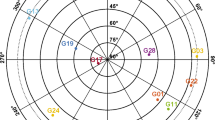Abstract
Using a low-cost single-frequency global positioning system (GPS) receiver for kinematic positioning, the ambiguity resolution requires longer data accumulation time compared to survey-grade dual-frequency receivers. A satellite-based augmentation system (SBAS) can provide added measurement to help solve this problem. However, the SBAS signal strength is weaker and the satellite orbit and clock errors are greater than those of GPS satellites. The difference in phase measurement quality between GPS and SBAS satellites must be considered to prevent an unstable positioning result or diverging position solution. This study proposes using the assisted adaptive extended Kalman filter (AAEKF) method to address this problem. The concept of AAEKF involves using measurements from the reference station to estimate the errors of each satellite. This information is then employed to dynamically adjust the corresponding measurement model of the extended Kalman filter. The proposed method was validated with 24 h of experiment data from four different baselines obtained using a consumer-grade L1 GPS receiver. The experimental results show that AAEKF can be successfully employed for GPS/SBAS kinematic positioning. The ambiguity resolution success rates of 2, 5, and 10 min of measurements improved by about 3.2, 2.4, and 1.6 times, respectively, and the positioning accuracy of the north, east, and height directions improved by 14–44, 17–56, and 9–53 %, when adding the SBAS measurement.



Similar content being viewed by others
References
Beutler G, Bauersima I, Gurtner W, Rothacher M, Schildknecht T, Geiger A (1988) Atmospheric refraction and other important biases in GPS carrier phase observations. In: Brunner FK (ed) Atmospheric effects on geodetic space measurements. Monograph 12, School of surveying NSW, Sydney, pp 15–44
Boriskin A, Kozlov D, Zyryanov G (2007) L1 RTK system with fixed ambiguity: what SBAS ranging brings. In: Proceedings of ION GNSS-2007, Fort Worth, TX, September 25–28, pp 2196–2201
Counselman CC III, Abbot RI (1989) Method of resolving radio phase ambiguity in satellite orbit determination. J Geophys Res 94:7058–7064
de Bakker PF, van der Marel H, Tiberius CJM (2008) Geometry-free undifferenced, single and double differenced analysis of single frequency GPS EGNOS and GIOVE-A/B measurement. GPS Solut 13(4):305–314. doi:10.1007/s10291-009-0123-6
Farrell J, Givargis T (2000) Differential GPS reference station algorithm: design and analysis. IEEE Trans Control Syst Technol 8(3):519–531. doi:10.1109/87.845882
Fotopoulos G, Cannon ME (2001) An overview of multi-reference station methods for cm-level positioning. GPS Solut 4(3):1–10. doi:10.1007/PL00012849
Frei E, Beutler G (1990) Rapid static positioning based on the fast ambiguity resolution approach “FARA”: theory and first results. Manuscr Geod 15:325–356
Gelb A (1974) Applied optimal estimation. MIT Press, Cambridge, MA. ISBN 0262570483
Hofmann-Wellenhof B, Lichtenegger H, Collins J (1994) Global positioning system theory and practice, 3rd edn. Springer, Wien, NY, pp 14, 124–127
Jin XX (1996) A new algorithm for generating carrier adjusted differential GPS corrections. J Geod 70(11):673–680. doi:10.1007/BF00867146
Klobuchar JA (1987) Ionospheric time-delay algorithm for single-frequency GPS users. IEEE Trans Aerosp Electron Syst AES 23(3):325–331. doi:10.1109/TAES.1987.310829
Kozlov D, Tkachenko M (1998) Centimeter level real-time kinematic positioning with GPS + GLONASS C/A receivers. Navigation 45(2):137–147
Leick A (2004) GPS satellite surveying, 3rd ed. Wiley, Hoboken, pp 172–177. ISBN: 978-0-471-05930-1
Lin SG, Yu FG (2013) Cycle slips detection algorithm for low cost single-frequency GPS RTK positioning. Surv Rev 45(330):206–214. doi:10.1179/1752270612Y.0000000034
Loomis P, Kremer G, Reynolds J (1989) Correction algorithms for differential GPS reference stations. Navigation 36(2):179–193
Mehra RK (1972) Approaches to adaptive filtering. IEEE Trans Autom Control AC 17(5):693–698. doi:10.1109/TAC.1972.1100100
Odijk D, van der Marel H, Song I (2000) Precise GPS positioning by applying ionospheric corrections from an active control network. GPS Solut 3(3):49–57. doi:10.1007/PL00012804
Parkinson BW, Spilker JJ Jr (1996) Global positioning system: theory and applications, vol 2. Wiley, London, pp 12–23
Skaloud J (1998) Reducing the GPS ambiguity search space by including inertial data. In: Proceedings of ION GPS-1998, Nashville, TN, September 15–18, pp 2073–2080
Takasu T, Yasuda A (2008) Evaluation of RTK-GPS performance with low-cost single-frequency GPS receivers. In: International symposium on GPS/GNSS 2008, November 11–14, Tokyo International Exchange Center, Japan 2008. RTKLIB: An Open Source Program Package for RTK-GPS. http://gpspp.sakura.ne.jp/rtklib/rtklib.htm
Teunissen PJG (1995) The least-squares ambiguity estimation decorrelation adjustment: a method for fast GPS integer ambiguity estimation. J Geod 70(1–2):65–82. doi:10.1007/BF00863419
Tiberius CCJM, de Jonge PJ (1995) Fast positioning using the LAMBDA-method. In: Proceedings of DSNS-95, Bergen, NOR, April 22–28, paper no. 30
Tsui JB (2005) Fundamentals of global positioning system receivers: a software approach. Wiley, Hoboken, NJ, pp 226–229
Vollath U, Buecherl A, Landau H, Pagels C, Wagner B (2000) Multi-base RTK positioning using virtual reference stations. In: Proc. ION GPS 2000, Salt Lake City, UT, September 19–22, pp 123–131
Wirola L, Alanen K, Käppi J, Syrjärinne J (2006) Bringing RTK to cellular terminals using a low-cost single-frequency AGPS receiver and inertial sensors, IEEE/ION PLANS 2006 conference, San Diego, CA, pp 24–27
Yang Y, He H, Xu G (2001) Adaptive robust filtering for kinematic geodetic positioning. J Geod 75:109–116
Zhang J, Lachapelle G (2001) Precise estimation of residual tropospheric delays using a regional GPS network for real-time kinematic applications. J Geod 75(5–6):255–266. doi:10.1007/s001900100171
Acknowledgments
The authors are grateful to a research Grant NSC 101-2221-E-019-070-MY3 from the National Science Council. The generous provision of GPS data for this study by the Institute of Earth Sciences Academia Sinica is greatly appreciated.
Author information
Authors and Affiliations
Corresponding author
Rights and permissions
About this article
Cite this article
Lin, SG. Assisted adaptive extended Kalman filter for low-cost single-frequency GPS/SBAS kinematic positioning. GPS Solut 19, 215–223 (2015). https://doi.org/10.1007/s10291-014-0381-9
Received:
Accepted:
Published:
Issue Date:
DOI: https://doi.org/10.1007/s10291-014-0381-9




